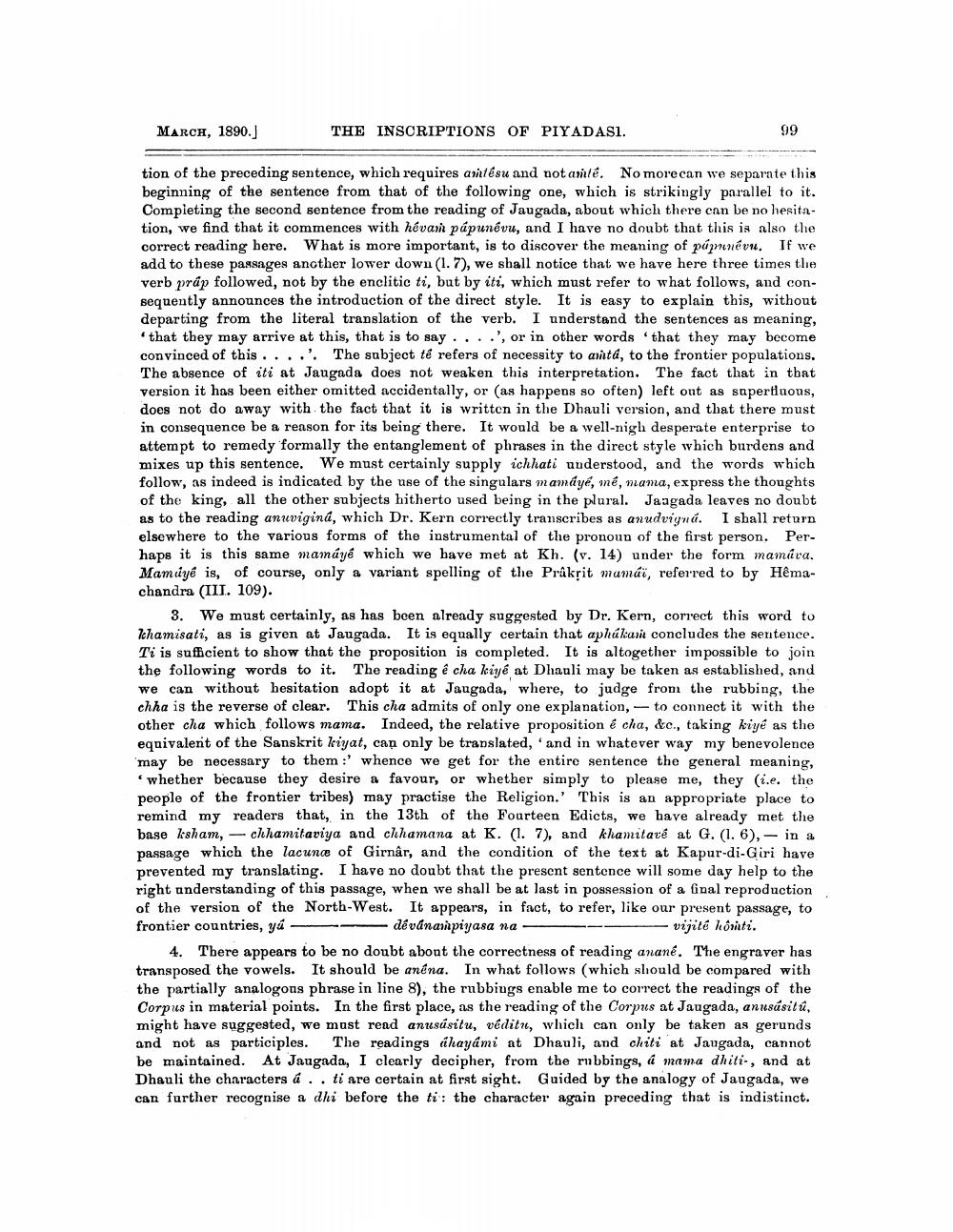________________
March, 1890.]
THE INSCRIPTIONS OF PIYADASI.
99
tion of the preceding sentence, which requires artêsu and not ante. No morecan we separate this beginning of the sentence from that of the following one, which is strikingly parallel to it. Completing the second sentence from the reading of Jaugada, about which there can be no hesitation, we find that it commences with hêvan pápunévu, and I have no doubt that this is also the correct reading here. What is more important, is to discover the meaning of páprunévn. If we add to these passages another lower down (1.7), we shall notice that we have here three times the verb práp followed, not by the enclitic ti, but by iti, which must refer to what follows, and consequently announces the introduction of the direct style. It is easy to explain this, without departing from the literal translation of the verb. I understand the sentences as meaning,
that they may arrive at this, that is to say ....', or in other words that they may become convinced of this ..... The subject té refers of necessity to annta, to the frontier populations. The absence of iti at Jaugada does not weaken this interpretation. The fact that in that version it has been either omitted accidentally, or (as happens so often) left ont as sapertiuous, does not do away with the fact that it is written in the Dhauli version, and that there must in consequence be a reason for its being there. It would be a well-nigh desperate enterprise to attempt to remedy formally the entanglement of phrases in the direct style which burdens and mixes up this sentence. We must certainly supply ichhati understood, and the words which follow, as indeed is indicated by the use of the singulars mamaye, mé, mama, express the thoughts of the king, all the other subjects hitherto used being in the plural. Jaagada leaves no doubt as to the reading anuvigind, which Dr. Kern correctly transcribes as anudvigná. I shall return elsewhere to the various forms of the instrumental of the pronoun of the first person. Perhaps it is this same mamáyé which we have met at Kh. (v. 14) under the form mamica. Mamuyé is, of course, only a variant spelling of the Průkrit mamãi, referred to by Hêmachandra (III. 109).
3. We must certainly, as has been already suggested by Dr. Kern, correct this word to khamisati, as is given at Jaugada. It is equally certain that aphúkari concludes the sentence. Ti is sufficient to show that the proposition is completed. It is altogether impossible to join the following words to it. The reading é cha kiyé at Dhauli may be taken as established, and we can without hesitation adopt it at Jaugada, where, to judge from the rubbing, the chha is the reverse of clear. This cha admits of only one explanation, - to connect it with the other cha which follows mama. Indeed, the relative proposition écha, &c., taking kiyê as the equivalent of the Sanskrit liyat, can only be translated, and in whatever way my benevolence may be necessary to them :' whence we get for the entire sentence the general meaning,
whether because they desire a favour, or whether simply to please me, they i.e. the people of the frontier tribes) may practise the Religion.' This is an appropriate place to remind my readers that, in the 13th of the Fourteen Edicts, we have already met the base ksham, - chhamitaviya and chhamana at K. (1. 7), and khamitaré at G. (1. 6), - in a passage which the lacunce of Girnar, and the condition of the text at Kapur-di-Giri have prevented my translating. I have no doubt that the present sentence will some day help to the right understanding of this passage, when we shall be at last in possession of a final reproduction of the version of the North-West. It appears, in fact, to refer, like our present passage, to frontier countries, yű dévánarpiyasa na -
- vijité horti. 4. There appears to be no doubt abont the correctness of reading anane. The engraver has transposed the vowels. It should be anena. In what follows (which should be compared with the partially analogons phrase in line 8), the rubbings enable me to correct the readings of the Corpus in material points. In the first place, as the reading of the Corpus at Jaugada, anusúsitú, might have suggested, we must read anusúsitu, véditu, which can only be taken as gerunds and not as participles. The readings chayámi at Dhauli, and chiti at Jaugada, cannot be maintained. At Jaugada, I clearly decipher, from the rubbings, á mama dhiti-, and at Dhauli the characters a.. ti are certain at first sight. Guided by the analogy of Jaugada, we can further recognise a dhi before the ti: the character again preceding that is indistinct.




